Tags
altarpiece, basilica, Germany, Krakow, Poland, reliquary, Saint Helena, Saint James, Saint Mary, Saint Matthias, Saint Peter, Trier, Veit Stoss

Veit Stoss, Saint Mary’s Altar (detail with Saint Matthias), Saint Mary’s Basilica, Krakow, Poland
The Kiss of Judas
Judas Iscariot, one of the original Twelve Apostles of Jesus, infamously betrayed Christ with a kiss in exchange for thirty pieces of silver. Following the Last Supper, Judas led the priests and Temple guards of the Sanhedrin to the Garden of Gethsemane, where he identified Jesus to the gathering crowd with a kiss. His treachery set in motion the events leading to the arrest, trial, and crucifixion of Jesus.

Giotto, The Kiss of Judas (1304-06), Scrovegni Chapel, Padua, Italy (courtesy Wikimedia Commons)
Upon learning that Jesus had been sentenced to death, Judas repented. According to the Gospel of Saint Matthew, “Then Judas, which had betrayed him, when he saw that he was condemned, repented himself, and brought again the thirty pieces of silver to the chief priests and elders, saying, I have sinned in that I have betrayed the innocent blood.”[1] Judas’s plea fell on deaf ears. “What is that to us?” the chief priests and elders responded.[2] Judas then “cast down the pieces of silver in the temple, and departed, and went and hanged himself.”[3] In a conflicting account, retold in the Acts of the Apostles, Peter states that Judas “purchased a field with the reward of iniquity; and falling headlong, he burst asunder in the midst, and all his bowels gushed out.”[4]
Whatever the manner of his death, Judas’s betrayal opened a void in the ranks of the Apostles. At a gathering of Jesus’ followers, which met shortly after the Ascension, Peter proposed that the vacancy in the Apostolate be filled. Two disciples were nominated: Joseph, who was known as Barsabas, and Matthias.
Once Barsabas and Matthias had been singled out, the group prayed for guidance. “Thou, Lord, which knowest the hearts of all men, shew whether of these two thou hast chosen, that he may take part of this ministry and apostleship, from which Judas by transgression fell, that he might go to his own place.”[5] They then drew lots to select Judas’s replacement. The lot fell on Matthias, “and he was numbered with the eleven apostles.”[6]
Not much is known of Matthias’s life following his election to the Apostolate.[7] Some sources claim he preached first in Judea and then Ethiopia before he was eventually crucified for his faith.[8] Others state he traveled to Ethiopia, where he preached near the sea of Hyssus, and died at Sebastopolis.[9] Still others declare he was stoned and then beheaded in Jerusalem.[10]

Reliquary of Saint Matthias, Trier, Germany
Ultimately, Saint Matthias’s relics were purportedly brought to Rome by Saint Helena – although some speculate that the relics in Rome are those of a different Matthias: Saint Matthias, Bishop of Jerusalem, who died in 120.[11] Some of Saint Matthias the Apostle’s relics were also translated to Trier, where they are currently kept in the crypt of the abbey church of Saint Matthias.

Abbey Church of Saint Matthias, Trier, Germany, prior to Mass
Depictions In Art
Compared with the other Apostles, including Judas, Saint Matthias is infrequently portrayed in works of art. His iconography is also less well-defined. For example, while keys are a sign of Saint Peter and seashells are a common attribute of Saint James, no single symbol has come to distinguish Saint Matthias in the visual shorthand of Christian art.
Veit Stoss and Saint Mary’s Altar
Veit Stoss’s magnificent Saint Mary’s Altar, located at the Basilica of Saint Mary in Krakow, Poland, includes one of the few depictions of Saint Matthias I’ve encountered. Carved in the late 15th century, Saint Mary’s Altar is the largest gothic altar in the world, measuring approximately 11 m (36 ft) long and 13 m (42.65 ft) high.[12] The altar, or retable, is constructed as a pentaptych consisting of a large central cabinet and two pairs of wings: an inner pair that is hinged and can be used to close the cabinet, and an outer pair that is fixed.[13] The altar is further supported by a predella and is surmounted by a finial of carved baldachins spread between thinly carved pillars.[14]

Veit Stoss, Saint Mary’s Altar, Saint Mary’s Basilica, Krakow, Poland
According to multiple sources, the doors of the altar are ordinarily kept closed during the liturgical year and are only opened for important feasts.[15] On several recent visits to Krakow, however, I noted that the doors were generally opened for a few hours each day to allow visitor’s to view the central scene of Stoss’s masterpiece. The central scene of the open retable depicts two important events in the life of Mary – the Death of the Virgin (or Dormition) and the Assumption – while a variety of Biblical episodes are represented on the wings of the altar.[16]
The Dormition depicts a youthful Mary falling to her knees at the moment of her passing.[17] Unlike more traditional depictions of Mary’s passing (such as the one pictured below), Stoss’s Dormition purposely omits references to death or dying to emphasize the extraordinary nature of Mary’s passage from earthly life.[18] There is no deathbed in Stoss’s scene, although Mary continues to be surrounded by Apostles, including Saint Peter and Saint John.[19]

Joos van Cleve, The Death of the Virgin (detail) (1520), Alte Pinakothek, Munich, Germany
In my opinion, in addition to Mary herself, three figures in particular stand out in Stoss’s portrayal of the Dormition. The first is Saint James.[20] Because of his central position and his dark, generous beard, the eye is naturally drawn to James, who stands above Mary, supporting her as she sinks to her knees. He is also one of the few figures that stares out towards to the viewer, seemingly making contact with the world outside the altar. The second is Saint John (pictured below), who stands to the right of Saint James, behind Mary.[21] John is holding a blue cloak or cape, which he is raising in an enigmatic gesture. Some suggest he is lifting it to his face to dry a tear while others argue he is extending it to Mary.[22] The third figure that stands out is purportedly Saint Matthias, whose unusual pose is noteworthy.[23]

Saint John (detail), from Saint Mary’s Altar
Like the representation of Saint James, the figure of Saint Matthias is also centrally located in the scene, although he is arranged even closer to the center of the composition. His position serves as a visual link between Mary and the saints of the Dormition, and the Assumption, which takes place in the sky above his head.[24] Matthias holds his hands outspread, his fingers interlaced, just above Mary’s head in a gesture some have described as one of protection.[25] To me, however, Matthias’s interlaced fingers are reminiscent of a crown, and his gesture is suggestive of a coronation. Matthias almost appears ready to place a crown on the kneeling Mary’s head. Could the arrangement have been intended to evoke Mary’s imminent coronation as Queen of Heaven?
It is interesting to speculate why Veit Stoss might have chosen to place Saint Matthias in so prominent a position on Saint Mary’s Altar. Alternatively, Saint Matthias may be the Apostle whose face, carved in profile, is just visible at the left of the composition. All twelve Apostles are present for Stoss’s Dormition, so Saint Matthias must be among them. In the absence of a clear pictorial tradition, however, identifying Matthias from among Stoss’s crowd of carved Apostles must remain a matter of conjecture. Nevertheless, as Rainer Kahsnitz notes in Carved Splendor: Late Gothic Altarpieces in Southern Germany, Austria, and South Tirol, “Presenting twelve apostles in a single scene—one or two of them young, the rest old and with flowing beards, was a notoriously difficult task for a Late Gothic artist. Only a very few carvers and painters proved themselves up to it.”[26] Of those, Veit Stoss may have been the best.

Interior of Saint Mary’s Basilica, Krakow, Poland, with Veit Stoss’s Saint Mary’s Altar in background
[1] Matthew 27:3 (King James Bible).
[2] Matthew 27:4.
[3] Matthew 27:5.
[4] Acts 1:18 (King James Bible).
[5] Acts 1:24-25.
[6] Acts 1:26.
[7] See “St. Matthias,” New Catholic Encyclopedia, available at http://www.newadvent.org/cathen/10066a.htm (providing a general overview of sources describing the ministry of Saint Matthias).
[8] Id. (citing Nicephorus, 2 Church History 40, in 1 Nicene and Post-Nicene Fathers (Philip Schaff ed., Arthur Cushman McGiffert trans, 1890)).
[9] Id. (citing the The Synopsis of Dorotheus).
[10] Id. (citing Louis-Sébastien Le Nain de Tillemont, 1 Mémoire pour servir à l’histoire ecclésiastique des six premiers siècle 406-7).
[11] Id. (citing Jean Bolland, Acta Sanctorum, Maii, III (1680)).
[12] Krzysztof Czyzewski, Veit Stoss: Mary’s Altar 10 (Aleksander Ptak et. al, trans. 2007).
[13] See id. at 10-11.
[14] Id. at 11.
[15] See, e.g., Czyzewski, supra note 12, at 11; Teresa Czerniewicz-Umer, Eyewitness Travel: Cracow 96 (2010).
[16] The following scenes are depicted on the internal wings of the altar and are visible when the doors are open: the Annunciation, the Nativity, the Adoration of the Magi, the Resurrection, the Ascension, and Pentecost. The following scenes are visible when the doors of the altar are closed: the Meeting of Saint Anne and Saint Joachim, the Birth of the Virgin, the Presentation of the Virgin in the Temple, the Presentation of Christ in the Temple, Christ Among the Doctors, the Capture of Christ, the Crucifixion, the Lamentation, the Entombment, Christ Appearing to Mary Magdalene (Noli me tangere), the Three Marys at the Sepulcher, and the Descent into Hell.
[17] Czyzewski, supra note 12, at 12. In her travel guide to Krakow, Teresa Czerniewicz-Umer opines that the “figure of the youthful Mary is one of the greatest sculptures ever made in Poland.” Czerniewicz-Umer, supra note 15, at 97.
[18] Czyzewski, supra note 12, at 12. In Carved Splendor: Late Gothic Altarpieces in Southern Germany, Austria, and South Tirol, Rainer Kahsnitz states, “In accordance with legendary tradition going back more than five hundred years—the Gospels say nothing about the death of the Virgin—the standard Dormition shows the apostles, miraculously transported from their far-flung missions, convened around Mary’s deathbed . . . .” Rainer Kahsnitz, Carved Splendor: Late Gothic Altarpieces in Southern Germany, Austria, and South Tirol 137 (2006).
[19] Rainer notes that portrayals of Mary kneeling in prayer before her death was a form that “spread from Bohemia to southeast Germany, Austria, and adjacent territories in the late fourteenth century.” Rainer, supra note 19, at 137.
[20] Rainer identifies this figure as possibly being Saint Paul rather than Saint James. Id. at 139.
[21] Rainer identifies this figure as possibly being Saint Philip rather than Saint John. Id. at 140.
[22] See, e.g., Czyzewski, supra note 12, at 29 (featuring a caption reading “St. John raises the rim of his coat to dry a tear,” which accompanies a detail of The Dormition); Czerniewicz-Umer, supra note 15, at 97 (featuring a caption beneath a detail of Saint John stating “the saint is about to put a cape on the fainting Mary”).
[23] Rainer identifies this figure as possibly being Saint John rather than Saint Matthias. Rainer, supra note 19, at 139.
[24] In the Assumption, Christ and Mary are being raised to heaven by angels.
[25] Czyzewski, supra note 12, at 12 (noting that one of the Apostles “protects” Mary with his “hands above Her”).
[26] Rainer, supra note 19, at 140.

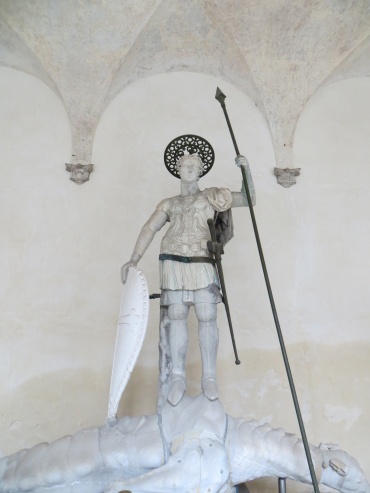 Saint Theodore Arrives in Venice
Saint Theodore Arrives in Venice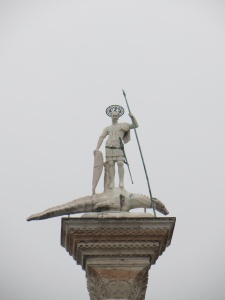 The first known mention of Saint Theodore of Amasea derives from a panegyric delivered by Saint Gregory of Nyssa near Saint Theodore’s tomb in Euchaita, modern-day Turkey.
The first known mention of Saint Theodore of Amasea derives from a panegyric delivered by Saint Gregory of Nyssa near Saint Theodore’s tomb in Euchaita, modern-day Turkey.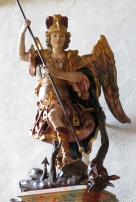

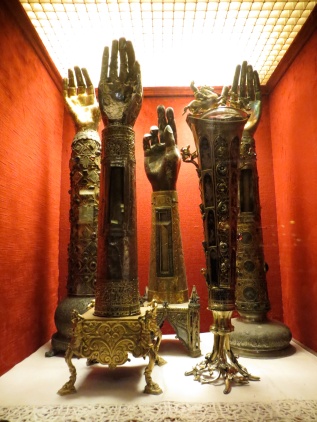
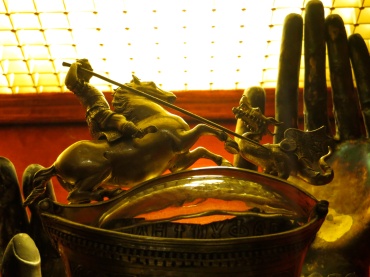
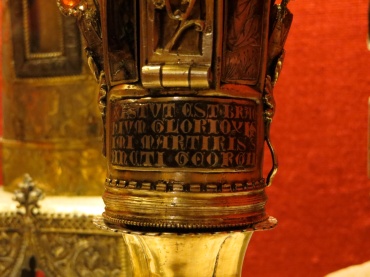
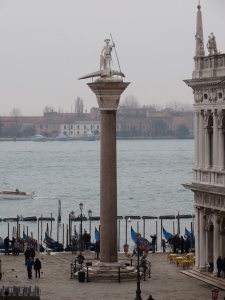 After the Venetians left Constantinople, some of the treasures they had appropriated were lost at sea and some were sold along the journey, but most of the objects arrived safely in Venice, where they were unloaded and unpacked at the Arsenale.
After the Venetians left Constantinople, some of the treasures they had appropriated were lost at sea and some were sold along the journey, but most of the objects arrived safely in Venice, where they were unloaded and unpacked at the Arsenale.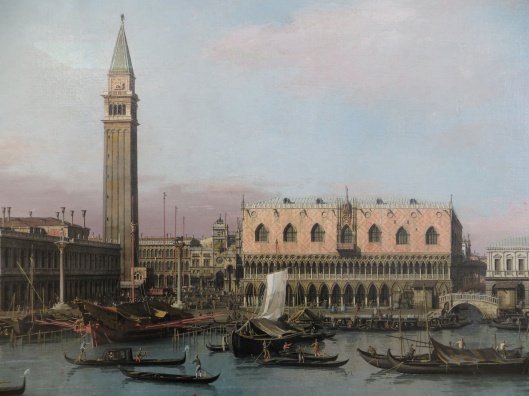

 Saint Mark, the symbol is everywhere in the city. Chiseled onto buildings, stamped onto tiles, and stitched into flags, it serves as a constant reminder of the enduring relationship between city and saint. The glorification of Saint Mark in Venetian culture, however, came at the expense of another saint, Saint Theodore of Amasea. Once Venice’s sole patron, Saint Theodore’s influence declined after Saint Mark’s arrival, although he is still afforded a place of honor atop a pillar in Saint Mark’s Square.
Saint Mark, the symbol is everywhere in the city. Chiseled onto buildings, stamped onto tiles, and stitched into flags, it serves as a constant reminder of the enduring relationship between city and saint. The glorification of Saint Mark in Venetian culture, however, came at the expense of another saint, Saint Theodore of Amasea. Once Venice’s sole patron, Saint Theodore’s influence declined after Saint Mark’s arrival, although he is still afforded a place of honor atop a pillar in Saint Mark’s Square.
 Akroyd explains, “The body of Saint Mark was taken out of the sarcophagus and unwrapped from its silk shroud, the relic being substituted by another and less eminent saint. It was then placed in a chest and taken on board the Venetian ship, the merchants first ensuring that the saint’s remains were covered by a layer of pork and cabbage. When the Muslim officials asked to inspect the chest, they cried out ‘Kanzir, kanzir’ (Oh horror) at the sight and smell of the pork. . . . Thus the evangelist was safely conveyed to Venice, but not before a number of miracles eased his passage across the Mediterranean.”
Akroyd explains, “The body of Saint Mark was taken out of the sarcophagus and unwrapped from its silk shroud, the relic being substituted by another and less eminent saint. It was then placed in a chest and taken on board the Venetian ship, the merchants first ensuring that the saint’s remains were covered by a layer of pork and cabbage. When the Muslim officials asked to inspect the chest, they cried out ‘Kanzir, kanzir’ (Oh horror) at the sight and smell of the pork. . . . Thus the evangelist was safely conveyed to Venice, but not before a number of miracles eased his passage across the Mediterranean.” Saint Mark’s body was initially kept in a chapel at the Doge’s palace, a chapel originally dedicated to Saint Theodore, until a more suitable church could be built. Begun in 829, the year after the translation of Saint Mark’s relics, the first church of Saint Mark was completed in 832. This church was destroyed in 976 during a rebellion against Doge Pietro Candiano IV. A second church was built in 1063 but was not consecrated until 1094, after Saint Mark’s relics, which had been lost in the years following the destruction of the first church, were rediscovered.
Saint Mark’s body was initially kept in a chapel at the Doge’s palace, a chapel originally dedicated to Saint Theodore, until a more suitable church could be built. Begun in 829, the year after the translation of Saint Mark’s relics, the first church of Saint Mark was completed in 832. This church was destroyed in 976 during a rebellion against Doge Pietro Candiano IV. A second church was built in 1063 but was not consecrated until 1094, after Saint Mark’s relics, which had been lost in the years following the destruction of the first church, were rediscovered. During my visit to the basilica, Saint Mark’s simple, marble sarcophagus could only be viewed from behind the high altar. The exterior of the sarcophagus was well lit and a short inscription applied to the stone in metallic letters read: “SALUTAT VOS . . . MARCUS FILIUS MEUS.” This inscription was followed by a citation in much smaller letters below the word “MEUS.” The citation read “1 Petri 5.13,” the source of the abbreviated quote on the tomb. The front of the sarcophagus apparently proclaims “CORPUS DIVI MARCI EVANGELISTAE” (Body of the Divine Mark, Evangelist).
During my visit to the basilica, Saint Mark’s simple, marble sarcophagus could only be viewed from behind the high altar. The exterior of the sarcophagus was well lit and a short inscription applied to the stone in metallic letters read: “SALUTAT VOS . . . MARCUS FILIUS MEUS.” This inscription was followed by a citation in much smaller letters below the word “MEUS.” The citation read “1 Petri 5.13,” the source of the abbreviated quote on the tomb. The front of the sarcophagus apparently proclaims “CORPUS DIVI MARCI EVANGELISTAE” (Body of the Divine Mark, Evangelist).